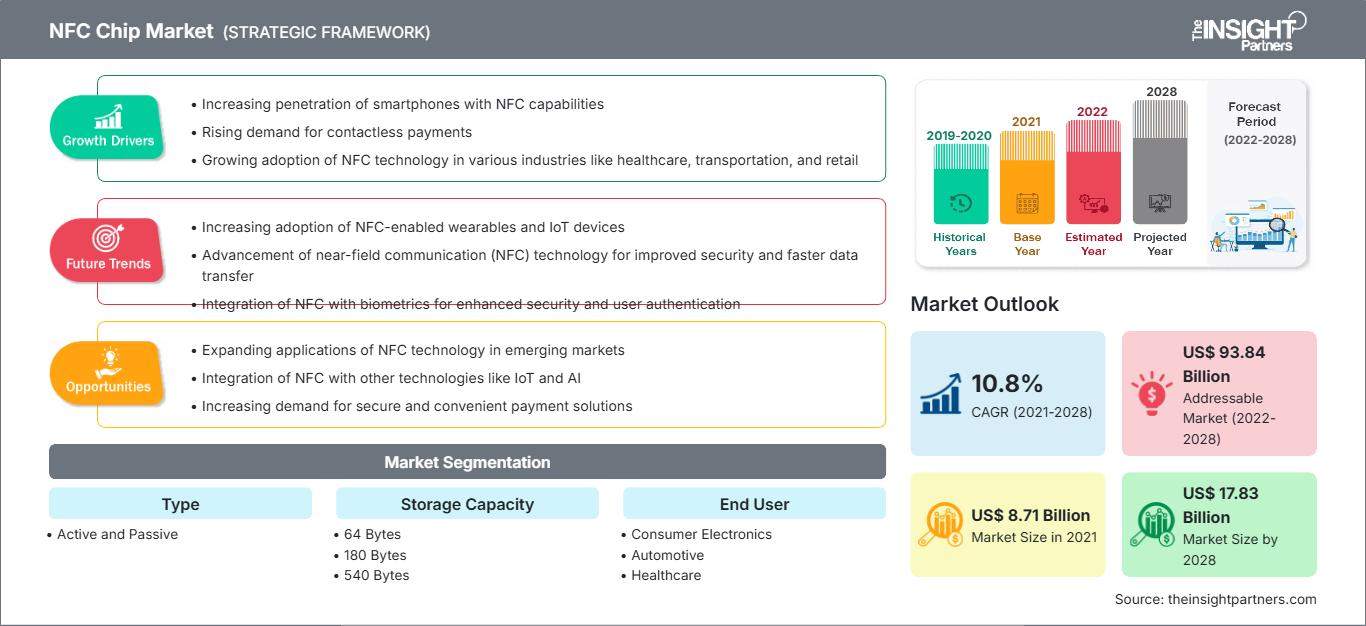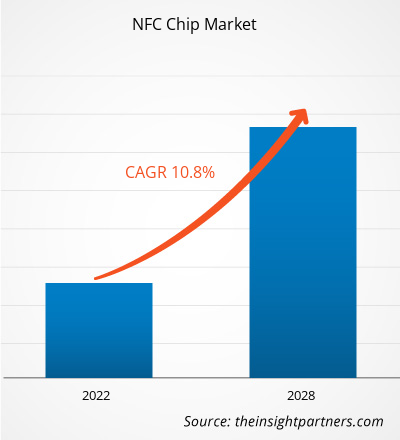Der Markt für NFC-Chips soll von 8.714,4 Millionen US-Dollar im Jahr 2021 auf 17.827,0 Millionen US-Dollar im Jahr 2028 wachsen; die durchschnittliche jährliche Wachstumsrate (CAGR) liegt zwischen 2021 und 2028 bei 10,8 %.
Smartphones sind aus dem Leben der heutigen Verbraucher nicht mehr wegzudenken. Sie nutzen ihre Mobiltelefone neben herkömmlichen Kommunikationsmitteln auch für schnellere Zahlungen. NFC ist ein praktisches Zahlungsmittel, da es das Mobilgerät des Verbrauchers mit seiner Brieftasche verbindet. Nutzer können damit mobile Transaktionen durchführen, schnell digitale Inhalte austauschen und ihre Geräte per Berührung mit anderen Geräten verbinden. Infolgedessen wächst die Zahl der mit NFC-Technologie ausgestatteten Geräte, was zur Verbreitung und Popularität der NFC-Technologie in Schwellenländern beiträgt. NFC-Chips vereinfachen die Nutzung von Benutzeroberflächen und machen sie so in Verbraucherprodukten nützlicher. Smartphone-Hersteller wie Apple und Samsung verbauen NFC-Chips in ihren Geräten, was zu einer steigenden Nachfrage nach NFC-Chips bei den Herstellern führt. Mit der zunehmenden Nutzung von Smartphones wird auch die Verbreitung von NFC zunehmen, was das Wachstum des NFC-Chip-Marktes beflügeln wird.
Zudem treibt die zunehmende Digitalisierung und verbesserte Kommunikationstechnologien die Nachfrage nach NFC-Chips an. Android Beam beispielsweise ist eine Funktion, die in jedem NFC-fähigen Android-Smartphone vorhanden ist. Nutzer können Medien und Kontakte mit anderen Android-Smartphones austauschen, indem sie ihre Telefone einfach nahe aneinander halten. Da NFC weniger Strom verbraucht und gelegentlich ohne Strom auskommt, ist es eine bequeme Möglichkeit, digitale Dateien zu teilen. Diese Faktoren wirken sich positiv auf das Wachstum des NFC-Chip-Marktes aus. Neben mobilen Zahlungen und der intelligenten Informationsverteilung funktioniert NFC auch im Peer-to-Peer-Modus. Es ermöglicht zwei Smartphones den Austausch von Kontakten, Kalenderaktivitäten, Website-Links, Bildern und sogar Videoclips, ähnlich wie Bluetooth und Wi-Fi Direct. NFC ist eine vielversprechende Tausch- und Handelslösung, und kleine Einzelhändler steigern ihre Gewinne, indem sie ihren Kunden reibungslose und einfachere Transaktionen bieten. Die oben aufgezeigten Vorteile der NFC-Technologie führen zu lukrativen Geschäftsmöglichkeiten für das Wachstum des NFC-Chip-Marktes.
Passen Sie diesen Bericht Ihren Anforderungen an
Sie erhalten kostenlos Anpassungen an jedem Bericht, einschließlich Teilen dieses Berichts oder einer Analyse auf Länderebene, eines Excel-Datenpakets sowie tolle Angebote und Rabatte für Start-ups und Universitäten.
NFC-Chip-Markt: Strategische Einblicke

-
Holen Sie sich die wichtigsten Markttrends aus diesem Bericht.Dieses KOSTENLOSE Beispiel umfasst Datenanalysen, die von Markttrends bis hin zu Schätzungen und Prognosen reichen.
Auswirkungen der COVID-19-Pandemie auf den NFC-Chip-Markt
Nordamerika weist aufgrund günstiger staatlicher Maßnahmen zur Förderung von Innovationen und Stärkung der Infrastruktur die höchste Akzeptanz und Wachstumsrate neuer Technologien auf. Daher wird erwartet, dass sich jegliche Auswirkungen auf die Industrie negativ auf das Wirtschaftswachstum der Region auswirken. Die USA waren aufgrund des COVID-19-Ausbruchs das weltweit am stärksten betroffene Land, was sich auf die hohe Akzeptanz des Online-Shoppings während der Pandemie auswirkte. Studien zufolge verzeichnete Amazon beispielsweise aufgrund der COVID-19-Pandemie einen Umsatzanstieg von 37 %.
Die Schließung aller Einzelhandelsgeschäfte durch die Regierungsbehörden in Verbindung mit den Vorschriften zur sozialen Distanzierung beeinträchtigte die Investitionen des Einzelhandels in technologische Fortschritte. Beispielsweise verzeichneten die Umsätze im Online-Lebensmittelgeschäft in den USA aufgrund der Pandemie einen Anstieg von 210,1 %. Dieser Anstieg des Online-Verkaufs von Verbrauchsgütern verringerte die Abhängigkeit der Bevölkerung der Region von stationären Geschäften. Die COVID-19-Pandemie hatte aufgrund der kontaktlosen und bargeldlosen Zahlung einen positiven Einfluss auf das Wachstum der NFC-Technologie, was wiederum den NFC-Chip-Markt ankurbelte.
Markteinblicke in NFC-Chips
Steigende Verbreitung von NFC-fähiger tragbarer Technologie
Tragbare Technologie ist ein neuer Trend, der Elektronik in alltägliche Aktivitäten integriert und auf veränderte Lebensstile reagiert, indem Geräte an jedem Körperteil getragen werden können. Tragbare Technologie basiert auf der Verbindung mit dem Internet und bietet die Möglichkeit zum Datenaustausch zwischen einem Netzwerk und einem Gerät. Aufgrund des zunehmenden Fitnesstrends unter den Verbrauchern erfreuen sich tragbare Geräte großer Beliebtheit. Laut Cisco Systems wird die Zahl vernetzter Wearables voraussichtlich von 593 Millionen im Jahr 2018 auf 1.105 Millionen im Jahr 2022 steigen. Dies ist auf zusätzliche Funktionen zurückzuführen, beispielsweise die Möglichkeit, die Marke an den Alltag anzupassen. Starke Marken wie Apple und Fossil halten ihre Preise im typischen Uhrenpreissegment konstant, um ihre Umsätze zu sichern. Viele weitere Premium-Uhrenhersteller wie TAG und Armani sind dank Googles WearOS in das Segment eingestiegen. Trotz erheblicher Platz- und Stromverbrauchsbeschränkungen erfreuen sich intelligente Wearables und IoT-Geräte durch zusätzliche Funktionen zunehmender Beliebtheit. NFC-fähige Wearables ermöglichen beispielsweise das Bezahlen im Geschäft, die Nutzung öffentlicher Verkehrsmittel oder den Zutritt zu Bürogebäuden. SECORA Connect beispielsweise ist eine Lösungsfamilie von Infineon, die der wachsenden Beliebtheit intelligenter Wearables und IoT-Geräte Rechnung trägt. Diese Systemlösung kann in intelligente Wearables integriert werden und ermöglicht kontaktloses, sicheres Bezahlen, Fahrkarten und andere Anwendungen mithilfe von Near Field Communication (NFC). Die oben genannten Faktoren treiben das Wachstum des NFC-Chipmarktes voran. Im Prognosezeitraum werden voraussichtlich weitere Investitionen und Wachstumspläne für diese Technologien erwartet, was Chancen für NFC-Chips in der Branche schaffen dürfte.
Endbenutzerbasierte Markteinblicke
Basierend auf dem Endbenutzer ist der NFC-Chipmarkt in Unterhaltungselektronik, Automobil, Einzelhandel, Medizin und andere segmentiert. Im Einzelhandel wurden aufgrund der steigenden Nachfrage nach kontaktlosen Zahlungen die meisten NFC-POS-Terminals weltweit installiert. Carrefour, ein in Frankreich ansässiger Einzelhändler, hat Carrefour Pay eingeführt – ein mobiles Zahlungssystem –, mit dem Benutzer ihre Lebensmittel mit ihren NFC-fähigen Smartphones am POS-Terminal bezahlen können. Das System wurde mit den Karten aller Banken verbunden und wird in 3.000 Filialen in Frankreich akzeptiert. Die Einführung dieses Systems ist Teil des Plans von Carrefour, digitale Abläufe zu gestalten, die durch eine Investition von 3,39 Milliarden US-Dollar unterstützt werden. Da ältere Systeme bald ausgemustert werden, integrieren POS-Anbieter NFC-Unterstützung zunehmend standardmäßig in neue Systeme. Darüber hinaus nutzen immer mehr Smartphone-Nutzer kontaktloses Bezahlen, da es schnell und bequem ist.
Markteinblicke nach Speicherkapazität
Basierend auf der Speicherkapazität ist der NFC-Chip-Markt in 64 Byte, 168 Byte, 180 Byte und 540 Byte unterteilt. NFC-Chips mit geringer Speicherkapazität werden für Bestandsverwaltung, Lieferkettenmanagement, Anlagenverfolgung sowie Automatisierung im Ticketing und zur Fälschungssicherheit eingesetzt. NFC-Chips mit hoher Speicherkapazität, beispielsweise 180 Byte und 540 Byte, verfügen über eine hohe Lese-/Schreibbeständigkeit und können Daten bis zu 50 Jahre lang speichern. Sie unterstützen außerdem SUN (Secure Unique NFC Message), was viele Anwendungen mit Sicherheit und Verschlüsselung ermöglicht und vereinfacht, wie z. B. erweiterte Fälschungssicherheit, Anwendungen zur Sicherung sensibler Daten, sichere Anmeldung und Authentifizierung.
NFC-Chip-Markt
Die Analysten von The Insight Partners haben die regionalen Trends und Faktoren, die den NFC-Chip-Markt im Prognosezeitraum beeinflussen, ausführlich erläutert. In diesem Abschnitt werden auch die Marktsegmente und die geografische Lage in Nordamerika, Europa, dem asiatisch-pazifischen Raum, dem Nahen Osten und Afrika sowie Süd- und Mittelamerika erörtert.Umfang des NFC-Chip-Marktberichts
| Berichtsattribut | Einzelheiten |
|---|---|
| Marktgröße in 2021 | US$ 8.71 Billion |
| Marktgröße nach 2028 | US$ 17.83 Billion |
| Globale CAGR (2021 - 2028) | 10.8% |
| Historische Daten | 2019-2020 |
| Prognosezeitraum | 2022-2028 |
| Abgedeckte Segmente |
By Typ
|
| Abgedeckte Regionen und Länder |
Nordamerika
|
| Marktführer und wichtige Unternehmensprofile |
|
Dichte der Marktteilnehmer für NFC-Chips: Auswirkungen auf die Geschäftsdynamik verstehen
Der NFC-Chip-Markt wächst rasant. Die steigende Nachfrage der Endnutzer ist auf Faktoren wie veränderte Verbraucherpräferenzen, technologische Fortschritte und ein stärkeres Bewusstsein für die Produktvorteile zurückzuführen. Mit der steigenden Nachfrage erweitern Unternehmen ihr Angebot, entwickeln Innovationen, um den Bedürfnissen der Verbraucher gerecht zu werden, und nutzen neue Trends, was das Marktwachstum weiter ankurbelt.

- Holen Sie sich die NFC-Chip-Markt Übersicht der wichtigsten Akteure
Akteure auf dem NFC-Chip-Markt verfolgen Strategien wie Fusionen, Übernahmen und Marktinitiativen, um ihre Position auf dem Markt zu behaupten. Im Folgenden sind einige Entwicklungen der wichtigsten Akteure aufgeführt:
- 2021 brachte Broadcom den weltweit stromsparendsten L1/L5-GNSS-Empfängerchip BCM4778 für mobile und tragbare Anwendungen auf den Markt.
Der globale NFC-Chip-Markt ist nach Typ, Speicherkapazität, Endbenutzer und Geografie segmentiert. Auf Grundlage des Typs ist der NFC-Chip-Markt in aktive und passive Chips segmentiert. Basierend auf der Speicherkapazität ist der Markt in 64 Byte, 168 Byte, 180 Byte und 540 Byte segmentiert. Basierend auf dem Endbenutzer ist der Markt in Unterhaltungselektronik, Automobil, Einzelhandel, Gesundheitswesen und andere segmentiert.
AMS AG; Broadcom Inc.; Identiv, Inc; Toshiba Corporation; Intel Corporation; NXP Semiconductors; Samsung Electronics Co., Ltd.; Qualcomm Technologies, Inc.; STMicroelectronics; und Texas Instruments Incorporated sind die wichtigsten Akteure auf dem NFC-Chip-Markt, die für die Studie berücksichtigt wurden. Darüber hinaus wurden in diesem Forschungsbericht mehrere weitere bedeutende Akteure auf dem NFC-Chip-Markt untersucht und analysiert, um einen ganzheitlichen Überblick über den globalen NFC-Chip-Markt und sein Ökosystem zu erhalten.
- Historische Analyse (2 Jahre), Basisjahr, Prognose (7 Jahre) mit CAGR
- PEST- und SWOT-Analyse
- Marktgröße Wert/Volumen – Global, Regional, Land
- Branchen- und Wettbewerbslandschaft
- Excel-Datensatz
Aktuelle Berichte
Erfahrungsberichte
Grund zum Kauf
- Fundierte Entscheidungsfindung
- Marktdynamik verstehen
- Wettbewerbsanalyse
- Kundeneinblicke
- Marktprognosen
- Risikominimierung
- Strategische Planung
- Investitionsbegründung
- Identifizierung neuer Märkte
- Verbesserung von Marketingstrategien
- Steigerung der Betriebseffizienz
- Anpassung an regulatorische Trends






















 Kostenlose Probe anfordern für - NFC-Chip-Markt
Kostenlose Probe anfordern für - NFC-Chip-Markt